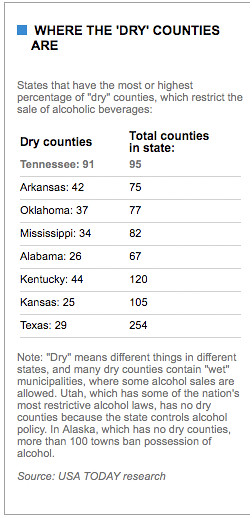
USA Today ran an interesting story earlier this month about the dry counties dotting still the landscape, areas within eight states where despite alcohol being legal statewide, it’s still illegal in those counties (along with some specific towns). According to Dry America’s Not-So-Sober Reality: It’s Shrinking Fast, many of the remaining 328 may soon become wet, too.
From the article:
Today, 1 in 9 counties is still dry. But drys are losing ground on all levels, from the state — since 2002, 14 states have ended bans on Sunday alcohol sales — to the very local. In April, a 19-block section of western Louisville (the M-107 precinct) voted 89-41 to go wet.
The number of Tennessee communities that allow sales of liquor by the drink (in bars and restaurants) has increased 56% since 2003. In the same period, 22 of Texas’ 254 counties and more than 235 of its municipalities have gone wet (or “moist,” a nebulous category in which beer and wine might be legal, but not liquor).
Even in Kansas — the state that produced the ax-wielding saloon-wrecker Carry Nation; that passed the first state prohibition law in 1881; and that did not repeal it until 1948 — 16 counties have gone wet since 2002.
One interesting side note is that economics is one of the most popular reasons, with communities wanting the tax revenue from alcohol sales. But that’s also the way that neo-prohibitionists have been going after alcohol, by trying to impose more and higher taxes. An interesting dichotomy, I’d say. Below is a nice chart of where the dry counties are and their number as compared to the total counties in each state.

